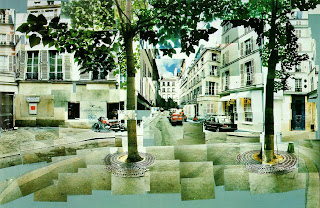
After hours of planning out how to achieve one of my concept sketches [refer to my blog for those] I undertook 2 hours of shooting from the balcony in the Mandella Hall [Queen's Student Union]. I tried to recreate the frenzy and fun that is had at a disco.
For this project we had, once again, a few guidelines to follow. The first decision to make was whether we would have our images function as art or as documents whilst having a narrative. I think I have blurred the lines and achieved both. This image can function as a piece of photographic collage art or it could be an account of student life seen from an abstract [Cubist] angle.
The ability to collapse time into one image was another requirement. This approach was favoured by photographer David Hockney. To achieve this I took many pictures from one position over a period of two hours. The only other variables I changed in my technique were Shutter Speed [ranging from 1/30sec up to 1minute] and my angle. My tripod ensured that the angle only changed along the horizontal axis and reduced the obvious peril of camera shake. This meant that my focal length, exposure and aperture were fixed which provided a basis for joining my images in Adobe Photoshop.
The final image shows how people behave inside the dance hall over the course of a night [10:30-00:30] and how their movements and interactions are influenced by alcohol and music. The tiled effect allows me to fragment the spheres of time and space and arrange them en masse to create a new narrative. This effect provides the ability to juxtapose solitary dancers from earlier in the night [like the woman in the centre left of the frame] with the frenzied crowds that Storm the dance floor towards the end. These harsh contrasts display the range of actions that dominate a night out- dancing, drinking, chatting and taking pictures. The tiles provide a barrage on the viewer's senses as they are presented with varying lighting, motion and colour. This recreates the befuddling and chaotic feel of a dance floor where people are continually bombarded with lights and the motion around them.
To support the sea of bodies in the centre of the image i needed to have a solid frame. In these sections of my panoramic image I refused to upset the time and space too much. To stay within my themes of time, space and motion I had to repeat the rectangular boxes but the railing remains very solid. The railing acts as my leading lines as they draw the eye around the image- sweeping from the epicentre to the left and right edges. The repeated colour patterns within the image [see below for details] also help guide the viewer around the image and remove some of the overwhelming array of colour and motion.
I have used Photoshop techniques called 'Colour Casting' and 'Colour Balancing' to repeat specific colours and use them as motifs. The chaotic sections shot at long shutter speeds appear as a brighter pink and white where as the earlier shots in the night appear as darker blues. I have also added hues to certain sections of the railing- to do this I made sections on the original layer then copied it onto a new layer to add a unique colour. This allowed me to go beyond the images I had and create many new coloured layers- the best example would be the bright yellow section on the bottom left of the image. It contrasts very well against the dull wood grain which it was previously a part of.
The influences for this piece include the work of David Hockney [1937-]. As a photographer he pioneered the extended photo-frame image and displayed an outstanding ability how to collapse moments in time.
He carefully composes his images using a variety of techniques. I have adopted his tiled effect and although some people may find it jarring- I see it as revolutionary. It takes photography from the basis of being able to capture time and motion to an elevated level where the two can be exploded and rearranged.
Another contemporary photographic influence would be Andreas Gursky [1955-]
From his work it is clear where I have taken the enormous scale and use of jarring colours. Like Gursky my panoramic would be printed and displayed on a large scale- 2m in width and 1m height at least.
Alain Paiment [1960-] was another great influence upon my work. His work centers upon architectural panoramic photos whilst providing an insight into human life. He shows the banal and the mundane- supported by the simplistic colours he uses [see below]. I have chosen to depict a slightly more exciting aspect of life so my colour palette had to be equally as vibrant- hence the bright blues and luminous greens.

Finally, as a member of the website http://www.flickr.com/ I am am to connect with photographers across the globe and view their work. I was struggling to find sources to reference my work and influence my post-processing so I surfed the plethora of images on flickr. Here are a few of the best that I found:

These show, as does the work of Hockney, how the collage technique (pioneered in photography by Henry Peach Robinson[1830-1901]) is used to create a disjointed yet coherent image. The effect is similar to the abstract art of Kasimir Malevich [1878-1935] or the photo-montage of John Heartfield [1891-1968].


















 2. Reflections
2. Reflections


